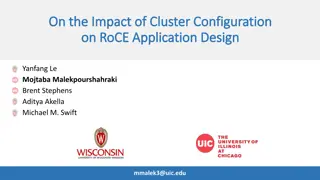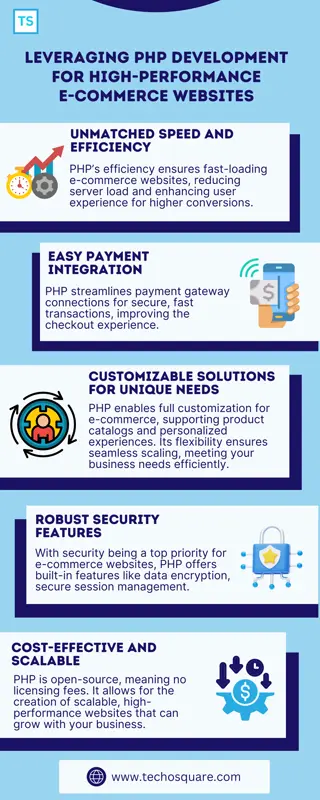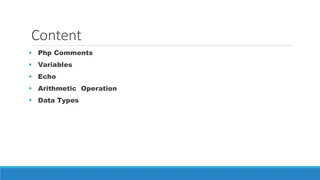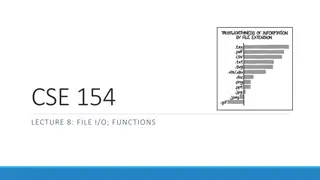
RDMA-Based Key-Value System with Remote Cache Implementation
Explore a fast RDMA-based ordered key-value system featuring remote cache utilization, presented by researchers from Shanghai Jiao Tong University. The system leverages RDMA technology for high-throughput, low-latency networking, enhancing distributed system performance and scalability. Key aspects include server-centric and client-direct designs, index caching, and RPC utilization.
Download Presentation

Please find below an Image/Link to download the presentation.
The content on the website is provided AS IS for your information and personal use only. It may not be sold, licensed, or shared on other websites without obtaining consent from the author. If you encounter any issues during the download, it is possible that the publisher has removed the file from their server.
You are allowed to download the files provided on this website for personal or commercial use, subject to the condition that they are used lawfully. All files are the property of their respective owners.
The content on the website is provided AS IS for your information and personal use only. It may not be sold, licensed, or shared on other websites without obtaining consent from the author.
E N D
Presentation Transcript
Fast RDMA-based Ordered Key-Value using Remote Learned Cache OSDI 20 XingdaWei, Rong Chen, and Haibo Chen Shanghai Jiao Tong University Presented by Shige Liu and Edwardzcn (Chuannan Zhang)
Outline Background Analysis and Motivation Design and Implementation Evaluation Conclusion 2 USTC-SYS Reading Group 4/19/2025
Outline Background Analysis and Motivation Design and Implementation Evaluation Conclusion 3 USTC-SYS Reading Group 4/19/2025
KVS: key pillar for distributed systems Server-centric design(S-RKV) Client-direct design(C-RKV) Index Caching 4 USTC-SYS Reading Group 4/19/2025
RPC Memory Memory Network RNIC RNIC CPU CPU 5 USTC-SYS Reading Group 4/19/2025
RDMA From one computer to another one Bypass both CPUs Permits high-throughput, low-latency networking Memory Memory Network RNIC RNIC 6 USTC-SYS Reading Group 4/19/2025
KVS: key pillar for distributed systems Server-centric design(S-RKV) RPC Client-direct design(C-RKV) RDMA Index Caching Cache 7 USTC-SYS Reading Group 4/19/2025
Server-centric design(S-RKV) Client Server RPC Network CPU RNIC RNIC CPU Get(K) = V B+Tree (K, V) 8 USTC-SYS Reading Group 4/19/2025
Client-direct design(C-RKV) Client Server RDMA Network CPU RNIC RNIC Get(K) = V N RTT B+Tree (K, V) 9 USTC-SYS Reading Group 4/19/2025
Index Caching Client Server RDMA Network CPU RNIC RNIC Get(K) = V B+Tree Tree-based Index Cache position (K, V) 10 USTC-SYS Reading Group 4/19/2025
Outline Background Analysis and Motivation Design and Implementation Evaluation Conclusion 11 USTC-SYS Reading Group 4/19/2025
Trade-off in existing KVS 12 USTC-SYS Reading Group 4/19/2025
Trade-off in existing KVS 13 USTC-SYS Reading Group 4/19/2025
Opportunity: ML Models The whole index caching Low latency Great memory efficiency 14 USTC-SYS Reading Group 4/19/2025
Contribution The idea of learned cache as index cache for RDMA-based, tree backed KV stores A hybrid architecture that combines learned cache and tree based index A layer of indirection that decouples ML retraining and allows a stale learned cache Xstore: A prototype implementation and an evaluation 15 USTC-SYS Reading Group 4/19/2025
Outline Background Motivation Design and Implementation Evaluation Conclusion 16 USTC-SYS Reading Group 4/19/2025
Overview of XSTORE Hybrid architecture[1] Static workloads GET, SCAN -> Client-direct Dynamic workloads INSERT, UPDATE -> Server-centric Client Server Insert, Update Network CPU RNIC RNIC CPU Learned Cache Request B+Tree 17 USTC-SYS Reading Group [1] Similar to existing RDMA-based KVS, e.g., FaRM@SOSP 15, Cell@ATC 4/19/2025
Learned Cache The key idea behind XSTORE Leverage ML models as cache structure for tree-based index instead of a homogeneous structure Motivated by the learned index[1] Key Position Training(retraining) models at the server Demands the positions (virtual address) are always sorted by the keys USTC-SYS Reading Group 18 [1] The case for the learned index @ SIGMOD 19 4/19/2025
Learned Cache Unique Features Cache whole (compared to partial) index Cost: accuracy Get: fewer network round trips and memory efficiency Predict approximately but simply (a single multiplication and addition) Reduce end-to-end latency even compared to a whole-index cache Reduce and delay cache invalidations Save invalidation cost in terms of network round trips and bandwidth usage. 19 USTC-SYS Reading Group 4/19/2025
Design: Data Structures XTree At the server B+tree index Key-value pairs at the leaf level physically Follow design of a concurrent B+tree[1] Server B+Tree Leaf Node LN LN LN INCA CNT NXT K0..KN-1V0..VN-1 20 USTC-SYS Reading Group [1] e.g. Masstree @ EuroSys 12 DBX @ EuroSys 14 4/19/2025
Design: Data Structures XCache (with TT) Train(retrain) at the server Host at the client 2-level recursive ML model (XModel) A translation table (TT) Client XModel train XCache TT XTree 21 USTC-SYS Reading Group [1] e.g. Masstree @ EuroSys 12 DBX @ EuroSys 14 4/19/2025
Design: Data Structures XModel Level 0: a multi-variate regression model Level 1: simple linear regression models Demands sorted positions Client NN XModel LR LR LR TT Logical Position [ ] Train(retrain) at the server Host at the client 2-level recursive ML model (XModel) A translation table (TT) TT ALN INCA CNT Actual Position [ ] 22 USTC-SYS Reading Group [1] e.g. Masstree @ EuroSys 12 DBX @ EuroSys 14 4/19/2025
Outline Background Motivation Design and Implementation Evaluation Conclusion 23 USTC-SYS Reading Group 4/19/2025
Evaluation of XStore Experimental Setup Testbed 1 server machine and (up to) 15 client machines CPU: 2 12-core Intel Xeon CPUs in each machine RAM: 128GB RNIC: 2 ConnectX-4 100Gbps IB RNICs Workloads YCSB Production workloads from Nutanix 24 USTC-SYS Reading Group 4/19/2025
Evaluation of XStore Answer the following questions: Comparing to server-centric designs? Comparing to client-direct designs? Does Xstore provide better trade-off? Compare targets DrTM-Tree @ Eurosys 16 eRPC+Masstree(EMT) @ NSDI 19 Cell @ ATC 16 RDMA-Memached(RMC) 25 USTC-SYS Reading Group 4/19/2025
YCSB Performance 26 USTC-SYS Reading Group 4/19/2025
YCSB Performance Read-only workload (C) Bottlenecked by CPU synchronizations 27 USTC-SYS Reading Group 4/19/2025
YCSB Performance Read-only workload (C) Bottlenecked by server CPU (server-centric design) 28 USTC-SYS Reading Group 4/19/2025
YCSB Performance Read-only workload (C) Traversing B+Tree with one-sided RDMA is costly! (client-direct design) 29 USTC-SYS Reading Group Cell has a 4-level cache in the client. 4/19/2025
YCSB Performance Read-only workload (C) XStore (82M req/s)even higher than optimal (80M req/s) 30 USTC-SYS Reading Group Cell has a 4-level cache in the client. 4/19/2025
YCSB Performance Static workloads (A, B, C, F) Update-heavy workloads still bottleneck XStore. 31 USTC-SYS Reading Group Cell has a 4-level cache in the client. 4/19/2025
YCSB Performance Static workloads (A, B, C, F) 32 USTC-SYS Reading Group Cell has a 4-level cache in the client. 4/19/2025
YCSB Performance Dynamic workloads (D, E) Dominated by scanning a large range of KV pairs 33 USTC-SYS Reading Group 4/19/2025
YCSB Performance Dynamic workloads (D, E) Suffer from performance fluctuations due to frequent cache invalidations. 4-level cache is more stable but performs worse. 34 USTC-SYS Reading Group 4/19/2025
YCSB Performance CPU utilizations Need retraining Use 2 auxiliary threads to retrain models. Save CPUs compared to S-RKV. End-to-end latency 35 USTC-SYS Reading Group 4/19/2025
Production Workload Performance Nutanix workload 36 USTC-SYS Reading Group 4/19/2025
Scale-out Performance One server -> More servers Scale to 6 server RNICs (3 server machines) 37 USTC-SYS Reading Group 4/19/2025
Others Models expansion Durability Logging to SSD Update-heavy: up to 24% drop Read-heavy: nearly no drop Variable-length Value Replaced by a 64-bit fat pointer An additional RDMA READ 38 USTC-SYS Reading Group 4/19/2025
Outline Background Analysis and Motivation Design and Implementation Evaluation Conclusion 39 USTC-SYS Reading Group 4/19/2025
Conclusion Contribution Provide a new design for RDMA-enabled KVS A new hybrid architecture Leverage ML model Provide better trade-offs Server-side CPU vs. Client-side memory vs.. Performance Limitations and future work fixed-length keys variable-length keys Currently focus on simple models 40 USTC-SYS Reading Group 4/19/2025
Fast RDMA-based Ordered Key-Value using Remote Learned Cache OSDI 20 Thanks Presented by Shige Liu and Edwardzcn (Chuannan Zhang)






















